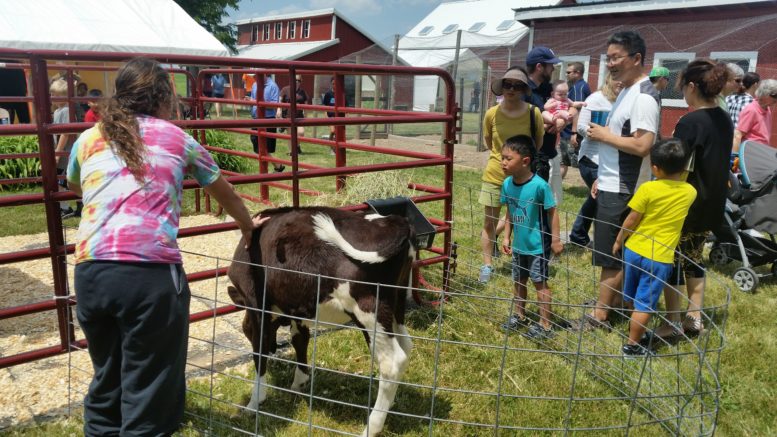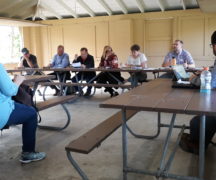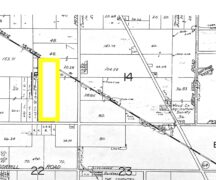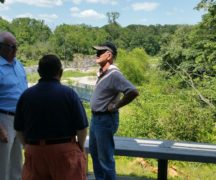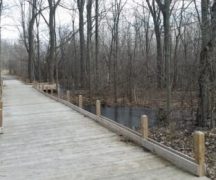By JAN LARSON McLAUGHLIN
BG Independent News
As a young boy, Tom Carpenter learned quickly that his neighbor, Everett Carter, liked things done a certain way. At age 12, Carpenter started mowing lawn for the aging farmer.
“Can you make straight lines,” Carpenter recalled Carter asking him.
“He was very, very particular. His home was immaculate,” Carpenter said.
Decades later, now Carpenter is the farmer of the land once planted and harvested by Carter. And as such, he approached the Wood County Park District Board on Tuesday about its plans to turn part of the old farm into a wetlands demonstration project.
The property has been in the park district’s hands for years, being donated by Everett’s daughter, Sally Loomis. The park district has maintained the farm, house and outbuildings as a historic site for visitors.
Carpenter complimented the park district for its efforts.
“If Sally Loomis were to pull in the property, she would be very appreciative” of the care given the buildings, and the animals being raised on the site north of Bowling Green, Carpenter said.
But he’s not so sure that Loomis would appreciate 20 acres of her former farmland being turned back into wetlands. Carpenter surmised that Loomis would prefer that the acreage continue to be used as productive farmland.
Wood County Park District Director Neil Munger explained the proposal to revert a portion of the farm back into wetlands would serve two purposes.
One is historic. “It would restore it to what it would have been back in the day,” Munger said.
The other reason is scientific. The wetlands proposal by the Black Swamp Conservancy would be a demonstration project to study how wetlands can be used to filter out nutrients from farm fields – before those nutrients reach streams and ultimately Lake Erie.
Carpenter said he is aware of runoff from farmland causing water quality problems in the region.
“I understand about 70 percent of what we put on farms can end up in Lake Erie,” he said.
The preliminary proposal calls for the wetlands to be located with a wooded buffer on 20 acres on the far west end of the farm. The acreage involved sits along a ditch that flows into Toussaint Creek. The wetlands would be designed to create wildlife habitat.
Munger said his conversations with Loomis led him to believe she would approve of the wetlands project, especially in light of the region’s water quality problems.
“She did talk about restoration of some areas,” Munger said. Loomis was a believer in education about farming and the natural history of the county – and donated the farm to the park district for that reason, he said.
Carpenter suggested that perhaps the park board could turn the wooded area on the farm into wetlands, rather than the productive farmland.
“I struggle with her feeling it should be turned into wetland, when she put a lot of money into it being drained,” he said. “I would like you to give this some serious thought.”
Park board president Denny Parish assured Carpenter that no decisions would be made on the property without public meetings.
“We will not take a vote on this without the public knowing,” Parish said.
In other business at the park board meeting:
- Munger reported on plans to get information out to voters about the park district’s renewal levy on the May ballot.
- The board approved plans for an employee manual that includes information for volunteers. The manual sets policies and defines requirements for background checks for volunteers.
- The board agreed to proceed with terms for an easement on the southern boundary of William Henry Harrison Park, to allow the village of Pemberville to install a waterline there. Nathan Schulte, the village water superintendent, said the town currently has two dead-end lines on Bierley Avenue and Water Street. The easement would allow the village to tie the lines.
- The park board accepted a bid to put acoustic panels on the ceiling in the W.W. Knight Nature Preserve great room. The $13,860 bid from Torrence Sound Equipment, of Perrysburg, was accepted.
- The board accepted bids to seal the parking lots at Otsego Park and Cedar Creek Park. The state will reimburse the park district once the work is complete. The product used will be Onyx, which was used to seal the Slippery Elm Trail last year. The cost will be $8,862 for Otsego and $11,891 for Cedar Creek.
- The board learned a park ranger manual is being designed.
- Munger announced that a citizen member is needed to serve as a park district representative for the North Coast Region Council of Park Districts Board. The board deals primarily with wetland mitigation projects.
- The board went into executive session to discuss personnel, and took no action when reconvening.

